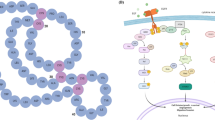Abstract
In this study the w/o/w extraction-evaporation technique was adopted to prepare poly(lactic-co-glycolic acid) (PLGA) microspheres loading recombinant human epidermal growth factor (rhEGF). The microspheres were characterized for morphology by transmission electron microscopy (TEM) and particle size distribution. The release performances, the proliferation effects and therapeutic effects of rhEGF-loaded PLGA microspheres were all studied. The results showed that these spherical microspheres had a narrow size distribution and a high drug encapsulation efficiency (85.6%). RhEGF-loaded microspheres enhanced the growth rate of fibroblasts and wound healing more efficiently than pure rhEGF. The number of the proliferating cell nuclear antigen (PCNA) in the epidermis layer with the microsphere treatment was significantly larger than those of the control groups. Overall locally sustained delivery of rhEGF from biodegradable PLGA microspheres may serve as a novel therapeutic strategy for diabetic ulcer repair.
Similar content being viewed by others
References
Rathur H M, Boultun A J M. The diabetic foot. Clin Dermatol, 2007, 25: 109–120, 17276208, 10.1016/j.clindermatol.2006.09.015
Clarke-Moloney M, Lyons G M, Burke P E, et al. A review of technological approaches to venous ulceration. Critical Rev Biomed Eng, 2005, 33(6): 511–556, 1:STN:280:DC%2BD28%2FgsVyjuw%3D%3D
Okumura K, Kiyohara Y, Komada F, et al. Improvement in wound healing by epidermal growth factor (EGF) ointment. I. Effect of nafamostat, gabexate, or gelatin on stabilization and efficacy of EGF. Pharm Res, 1990, 7(12): 1289–1293, 2128896, 10.1023/A:1015946123697, 1:CAS:528:DyaK3MXjs1KhsQ%3D%3D
Couvreur P, Blanco-Prieto M J, Puisieux F, et al. Multiple emulsion technology for the design of microspheres containing peptides and oligopeptides. Adv Drug Deliver Rev, 1997, 28(1): 85–96, 10.1016/S0169-409X(97)00052-5, 1:CAS:528:DyaK2sXntVOjsrk%3D
Jorgensen L, Moeller E H, van de Weert M, et al. Preparing and evaluating delivery systems for proteins. Eur J Pharm Sci, 2006, 29: 174–182, 16828267, 10.1016/j.ejps.2006.05.008, 1:CAS:528:DC%2BD28XhtFentr%2FL
Freiberg S, Zhu X X. Polymer microspheres for controlled drug release. Int J Pharm, 2004, 282: 1–18, 15336378, 10.1016/j.ijpharm.2004.04.013, 1:CAS:528:DC%2BD2cXntVGhs7o%3D
Kishan V, Oliver D W, Dillis V V, et al. Growth factor modulation of fibroblast proliferation, differentiation, and invasion: Implications for tissue valve engineering. Tissue Eng, 2006, 12(10): 2707–2716, 10.1089/ten.2006.12.2707
Kwon Y B, Kim H W, Roh D H, et al. Topical application of epidermal growth factor accelerates wound healing by myofibroblast proliferation and collagen synthesis in rat. J Vet Sci, 2006, 7(2): 105–109, 16645332
Reis C P, Neufeld R J, Ribeiro A J, et al. Nanoencapsulation. II. Biomedical applications and current status of peptide and protein nanoparticulate delivery systems. Nat Med, 2006, 2(2): 53–65, 1:CAS:528:DC%2BD28XntVCgtbc%3D
Kim T H, Lee H, Park T G. Pegylated recombinant human epidermal growth factor (rhEGF) for sustained release from biodegradable PLGA microspheres. Biomaterials, 2002, 23: 2311–2317, 12013178, 10.1016/S0142-9612(01)00365-9, 1:CAS:528:DC%2BD38**tlaktb8%3D
Cleland J L, Duenas E T, Park A, et al. Development of poly-(D,L-lactide-coglycolide) microsphere formulations containing recombinant human vascular endothelial growth factor to promote local angiogenesis. J Control Release, 2001, 72: 13–24, 11389981, 10.1016/S0168-3659(01)00258-9, 1:CAS:528:DC%2BD3MXktVGlu7Y%3D
Loo J S C, Ooi C P, Boey F Y C. Degradation of poly(lactide-co-glycolide) (PLGA) and poly(L-lactide) (PLLA) by electron beam radiation. Biomaterials, 2005, 26(12): 1359–1367, 15482823, 10.1016/j.biomaterials.2004.05.001, 1:CAS:528:DC%2BD2cXosFSltbw%3D
Anderson J M, Shive S M. Biodegradation and biocompatibility of PLA and PLGA microspheres. Adv Drug Delivery Rev, 1997, 28(1): 5–24, 10.1016/S0169-409X(97)00048-3, 1:CAS:528:DyaK2sXntVKqu70%3D
Liu X Y, Chang J, Guo Y S, et al. Preparation of the Immunonanoparticles Targeting to Lens Epithelial Cells. Chin J Biomed Eng, 2004, 23(6): 583–588, 1:CAS:528:DC%2BD2MXnsF2rsLw%3D
Sun T Z, Wang Y P, Yang Y H, et al. Comparison of the effects of rhEGF with rhbFGF on the acceleration of wound healing. Chin J Reparat Reconstruct Surg, 1999, 13(5): 278–282, 1:CAS:528:DC%2BD3cXkvF2itA%3D%3D
Prelich G, Tan C K, Kostura M, et al. Functional identity proliferating cell nuclear antigen and a DNA polymerase delta auxiliary protein. Nature, 1987, 326: 517–520, 2882424, 10.1038/326517a0, 1:CAS:528:DyaL2sXhvFWntrw%3D
Author information
Authors and Affiliations
Corresponding author
Additional information
Supported by the National Natural Science Foundation of China (Grant No. 50373033), the Applied Foundational Research Key Fund of Tian** (Grant No. 05YFJZJC01001) and the International Cooperative Fund of Tian** (Grant No. 05YFGHHZ20070)
Rights and permissions
About this article
Cite this article
Dong, X., Xu, J., Wang, W. et al. Repair effect of diabetic ulcers with recombinant human epidermal growth factor loaded by sustained-release microspheres. SCI CHINA SER C 51, 1039–1044 (2008). https://doi.org/10.1007/s11427-008-0126-5
Received:
Accepted:
Published:
Issue Date:
DOI: https://doi.org/10.1007/s11427-008-0126-5




